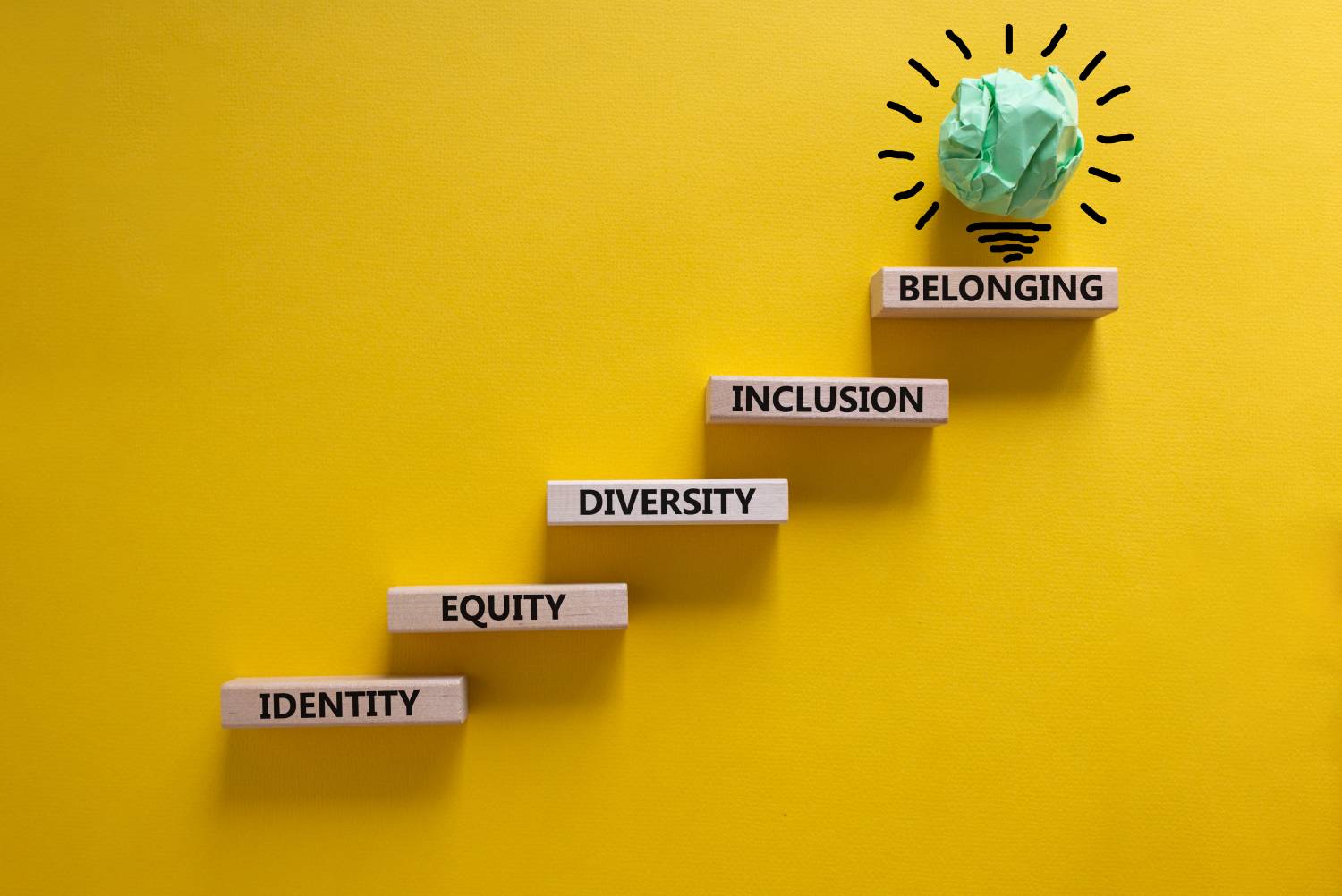DEI policies and practices.
Many organizations consider DEI a mindset, a way of looking at organization, collaboration, and getting things done. Creating policies is a practical step to facilitating this mindset and ensuring its long-term success and sustainability.
Why? Because policies are an accessible guideline for employees and leaders to base actions and behaviors on. In a fast-changing organization, they are a reliable base to fall back on if needed. Practices can change rapidly, and DEI policies will help you ensure equal treatment of your staff throughout the years.
Action 1: essential DEI policies
Action 1: Essential DEI policies
There are three types of DEI policies, each with a specific impact.
What? A high-level overview of your organization’s DEI mission, vision, and values and your commitment to DEI.
Impact? This text must inspire. It is a starting point. All specific equal opportunity policies come from the commitments described in this text.
Example? Here you go.
What? A policy that helps prevent discrimination and harassment in the workplace. They are often part of the Code of Conduct and define the boundaries of acceptable behavior at work.
Impact? The desired effect of these policies is to protect employees from discrimination or harassment by colleagues, leaders, or partners at work, allowing them to do their job in a safe environment. They can also help people signal or report undesired behaviors or practices.
Is a policy enough? For most companies, this kind of policy helps them comply with national laws for employee protection.
Often there is a need to actively train and remind employees of the content of this policy, especially after reported incidents of discrimination or harassment. In addition, leaders need to role-model, coach, and provide employees feedback to encourage the preferred behaviors.
It is essential to integrate information about your report/complaint procedure. For example, where can employees report bias, discrimination, or harassment incidents, who to notify, which support to expect, and what follow-up procedures are in place?
Example? Here you go.
What? Besides the inspiring DEI statement and compliance-driven non-discrimination and harassment policies, organizations can create additional policies targeting specific areas. Those are tools with concrete guidelines for staff to ensure equal opportunities. For example, describing ongoing actions that the organization commits to.
Impact? The areas targeted in specific equal opportunity policies depend on the organization’s needs and the priorities defined in the DEI Strategic Plan.
Areas of impact can be:
- Recruitment & Hiring: e.g., unbiased candidate attraction and selection, diverse interview- and hiring panels, etc.
- Professional development & Advancement: e.g., more specifically, equal learning and development opportunities, evaluation and feedback processes, promotion procedures, etc.
- Retention and Workplace Inclusion: e.g., equal pay and benefits, mentoring and sponsoring, flexible work options, reasonable accommodation for employees with a disability, etc.
Overall, policies guide staff in their actions, define the organization’s and employees’ responsibility, and ensure a stable interpretation and execution of a mission and vision in those areas in the long term.
Example? Here you go.
![]()
Want to create valuable and sustainable DEI policies?
Here are three tips for doing so:
- Focus on installing systems of equity and inclusive culture in which all employees can thrive, not only on the representation of various demographics.
- Establish accountability. Who is responsible for creating, following up, and updating DEI policies? Who is held accountable for correct execution?
- Define metrics to gain insight into the execution of policies and to drive policy evolution through time. DEI is an ever-changing field.
Should we integrate DEI into existing policies or create dedicated DEI policies?
That depends on your starting point.
If your current policies already reference DEI topics, you can build on them and extend the policies where necessary.
If you start from scratch, you can go either way. Reflect on which option will make the policies most accessible and visible in your organization.
No matter the option, collaborate with your legal or communications department to create explicit policy texts that are easy to understand and implement.
Action 2: from policies to practices
Action 2. From policies to practices
Good policy = good practice?
Having good policies is one thing. Putting them into practice consistently throughout the organization is entirely different. Policy interpretation and execution of follow-up depend on the department, level, team, or individual manager.
E.g., the company has a policy on flexible hours, but a manager decides to schedule short check-in meetings with the team every day at 9 AM. Therefore, the team cannot enjoy the flexibility the organization offers in the same way as other teams do.
That, of course, negates the goals of these policies, i.e., ensuring equal opportunities for all.
What is needed to have an egalitarian implementation of DEI policies throughout the organization?
- Critical analysis of the current practices in the organization:
- How are policies implemented at different levels, departments, functions, and teams?
- Are there any barriers preventing certain employees from the full benefit of using policies as intended?
- Check your current policies and practices using the DEI Checklist created by the Center for Equity, Gender, and Leadership of the Haas School of Business, University of California, Berkeley.
- Guidance and training for people managers:
- Are all policies accessible and crystal clear?
- What practical barriers do managers experience when implementing policies?
- Accountability for the execution in all levels of leadership:
- Communicate what the consequences are for leaders who do not comply. Going against the policies means they do not facilitate equal opportunities for employees.
![]()
Are you part of a small organization and wondering if you need DEI policies?
The main idea is to have internal conversations about how to provide equal opportunities. Producing comprehensive documents in which you formalize rules is not always necessary. Instead, make sure you regularly reflect on the “What ifs” so your leaders and employees are on the same page and make agreements to ensure equality.
Action 3: communication
Action 3. Communication
Typically, significant policies are created with much care by a dedicated team, after which one of two things will happen:
- They appear on the organization’s intranet or website, tucked away in a maze of hyperlinks and pages no one ever uses, which makes them hard to find.
- They are part of the onboarding documents for new employees, given at a time of information overload. They compete with necessary information regarding paychecks, insurance, a company car, holiday arrangements, etc., and disappear in a drawer after a few days.
Both are not ideal. Information that helps ensure equity is essential, but realistically, only a few people will take the time to look for it.
Reflect:
- Where will you place the policies? Are they accessible to all employees?
- Do you communicate about the existence and location of the policies? Do you remind employees regularly of where to find them?
- Do you challenge leaders on their knowledge of the policies? Do you guide them in communicating about them? Do you train them on how to implement the policies to ensure equity for team members?
Collaborate with your legal or communications department to create explicit policy texts that are easy to implement.
Become a DEI expert.
This is a collection of articles that allows you to take a deep dive.

Services | Inclusion Now

Tabi on Racial Matters: Are Black and marginalised employees supported by diversity and inclusion policies? – Openforum


